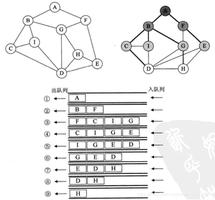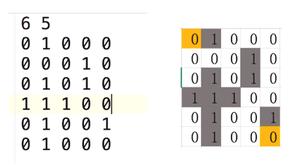Python中矩阵的广度优先搜索
在给定的矩阵中,有四个对象可以分析元素位置:左、右、下和上。
广度优先搜索只不过是找到给定二维矩阵的两个元素之间的最短距离。因此,在每个单元格中,我们可以执行四种操作,可以用四个数字表示,例如,
“2”描述矩阵中的单元格是源。
'3' 描述矩阵中的单元格是 Destination。
“1”描述单元格可以在一个方向上进一步移动。
'0' 表示矩阵中的单元格不能向任何方向移动。
在adobe justification的基础上,我们可以对给定的矩阵执行广度优先搜索操作。
解决这个问题的方法
使用 BFS 遍历整个矩阵并找到任何单元格之间的最小或最短距离的算法如下:
首先获取行和列的输入。
使用给定的行和列初始化矩阵。
整数函数 shortestDist(int row, int col, int mat[][col]) 将行、列和矩阵作为输入,并返回矩阵元素之间的最短距离。
初始化变量源和目标以找出源和目标元素。
如果元素为“3”,则将其标记为目标;如果元素为“2”,则将其标记为源元素。
现在初始化队列数据结构以在给定矩阵上实现广度优先搜索。
将矩阵的行和列成对插入队列中。现在在单元格中移动并找出它是否是目标单元格。如果目标单元格的距离最小或小于当前单元格,则更新距离。
再次移动到另一个方向以找出单元格与当前单元格的最小距离。
返回最小距离作为输出。
示例
import queue输出结果INF = 10000
class Node:
def __init__(self, i, j):
self.row_num= i
self.col_num= j
def findDistance(row, col, mat):
source_i = 0
source_j = 0
destination_i = 0
destination_j = 0
for i in range(0, row):
for j in range(0, col):
if mat[i][j] == 2 :
source_i = i
source_j = j
if mat[i][j] == 3 :
destination_i = i
destination_j = j
dist = []
for i in range(0, row):
sublist = []
for j in range(0, col):
sublist.append(INF)
dist.append(sublist)
# initialise queue to start BFS on matrix
q = queue.Queue()
source = Node(source_i, source_j)
q.put(source)
dist[source_i][source_j] = 0
# modified BFS by add constraint checks
while (not q.empty()):
# extract and remove the node from the front of queue
temp = q.get()
x = temp.row_num
y = temp.col_num
# If move towards left is allowed or it is the destnation cell
if y - 1 >= 0 and (mat[x][y - 1] == 1 or mat[x][y - 1] == 3) :
# if distance to reach the cell to the left is less than the computed previous path distance, update it
if dist[x][y] + 1 < dist[x][y - 1] :
dist[x][y - 1] = dist[x][y] + 1
next = Node(x, y - 1)
q.put(next)
# If move towards right is allowed or it is the destination cell
if y + 1 < col and (mat[x][y + 1] == 1 or mat[x][y + 1] == 3) :
# if distance to reach the cell to the right is less than the computed previous path distance, update it
if dist[x][y] + 1 < dist[x][y + 1] :
dist[x][y + 1] = dist[x][y] + 1
next = Node(x, y + 1)
q.put(next);
# If move towards up is allowed or it is the destination cell
if x - 1 >= 0 and (mat[x - 1][y] == 1 or mat[x-1][y] == 3) :
# if distance to reach the cell to the up is less than the computed previous path distance, update it
if dist[x][y] + 1 < dist[x - 1][y] :
dist[x - 1][y] = dist[x][y] + 1
next = Node(x - 1, y)
q.put(next)
# If move towards down is allowed or it is the destination cell
if x + 1 < row and (mat[x + 1][y] == 1 or mat[x+1][y] == 3) :
# if distance to reach the cell to the down is less than the computed previous path distance, update it
if dist[x][y] + 1 < dist[x + 1][y] :
dist[x + 1][y] = dist[x][y] + 1
next = Node(x + 1, y)
q.put(next)
return dist[destination_i][destination_j]
row = 5
col = 5
mat = [ [1, 0, 0, 2, 1],
[1, 0, 2, 1, 1],
[0, 1, 1, 1, 0],
[3, 2, 0, 0, 1],
[3, 1, 0, 0, 1] ]
answer = findDistance(row, col, mat);
if answer == INF :
print("No Path Found")
else:
print("The Shortest Distance between Source and Destination is:")
print(answer)
The Shortest Distance between Source and Destination is:2
以上是 Python中矩阵的广度优先搜索 的全部内容, 来源链接: utcz.com/z/350516.html







